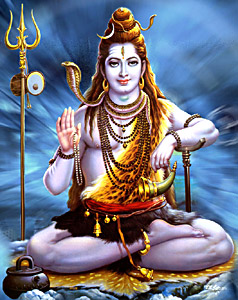`Shambhu Sundari, the undecaying immortal form, by the eye of yogic vision I extract the som afrom the crown chakra and offer it to you, who dwell in the enkindled kundalini fire in the muladhara.`- Ganapata Muni
 The state of Shiva called Shambhu, the source of well being for the entire world is expressed in the Shambhavi mudra of Shiva. Shambhavi, a name related to Lord Shiva, describes the arousal of new energies in tantric practice. Shambhavi, in which the eyes remain half open externally directs the attention of an entity within, is one of the greatest secret of Tantras. The natural movement of Shakti is to direct the entire attention to the soul and synthesizing the macrocosm into Him. Shambhavi is the form of the goddess who epitomizes the process of offering the head, mind and eye to Shiva. Chinnamasta(the Maha Vidya Goddess whose image is a severed head) and Sundari ( the devi who manifests the highest beauty of perception) are also Shambhavi as they replaced the outer world off yearning and cravings with the inner world of "soma" and "ananda."
The state of Shiva called Shambhu, the source of well being for the entire world is expressed in the Shambhavi mudra of Shiva. Shambhavi, a name related to Lord Shiva, describes the arousal of new energies in tantric practice. Shambhavi, in which the eyes remain half open externally directs the attention of an entity within, is one of the greatest secret of Tantras. The natural movement of Shakti is to direct the entire attention to the soul and synthesizing the macrocosm into Him. Shambhavi is the form of the goddess who epitomizes the process of offering the head, mind and eye to Shiva. Chinnamasta(the Maha Vidya Goddess whose image is a severed head) and Sundari ( the devi who manifests the highest beauty of perception) are also Shambhavi as they replaced the outer world off yearning and cravings with the inner world of "soma" and "ananda."
Another way of elucidating the name "Shambhavi" is to state how it is related to the name of other Gods. "Sham" defines Shanti, peace and implies the balance of "pratia" and "apana", the energies of Sun and Moon, time and space and of Shiva and Shakti. Another meaning of Sham symbolizes "bija" the seed mantra for Shani Deva( the planet Saturn). Shambhu also symbolizes the blessing of fire.
The real experimental truth about Tantra is that the passion becomes the thirst, the alliance with the entity and the greater existence.
This article is a stub. You can enrich by adding more information to it. Send your Write Up to [email protected]









